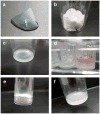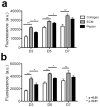Injectable skeletal muscle matrix hydrogel promotes neovascularization and muscle cell infiltration in a hindlimb ischemia model
- PMID: 22665162
- PMCID: PMC3524267
- DOI: 10.22203/ecm.v023a31
Injectable skeletal muscle matrix hydrogel promotes neovascularization and muscle cell infiltration in a hindlimb ischemia model
Abstract
Peripheral artery disease (PAD) currently affects approximately 27 million patients in Europe and North America, and if untreated, may progress to the stage of critical limb ischemia (CLI), which has implications for amputation and potential mortality. Unfortunately, few therapies exist for treating the ischemic skeletal muscle in these conditions. Biomaterials have been used to increase cell transplant survival as well as deliver growth factors to treat limb ischemia; however, existing materials do not mimic the native skeletal muscle microenvironment they are intended to treat. Furthermore, no therapies involving biomaterials alone have been examined. The goal of this study was to develop a clinically relevant injectable hydrogel derived from decellularized skeletal muscle extracellular matrix and examine its potential for treating PAD as a stand-alone therapy by studying the material in a rat hindlimb ischemia model. We tested the mitogenic activity of the scaffold's degradation products using an in vitro assay and measured increased proliferation rates of smooth muscle cells and skeletal myoblasts compared to collagen. In a rat hindlimb ischemia model, the femoral artery was ligated and resected, followed by injection of 150 µL of skeletal muscle matrix or collagen 1 week post-injury. We demonstrate that the skeletal muscle matrix increased arteriole and capillary density, as well as recruited more desmin-positive and MyoD-positive cells compared to collagen. Our results indicate that this tissue-specific injectable hydrogel may be a potential therapy for treating ischemia related to PAD, as well as have potential beneficial effects on restoring muscle mass that is typically lost in CLI.
Figures









Similar articles
-
Extracellular Matrix Hydrogel Promotes Tissue Remodeling, Arteriogenesis, and Perfusion in a Rat Hindlimb Ischemia Model.JACC Basic Transl Sci. 2016 Jan-Feb;1(1-2):32-44. doi: 10.1016/j.jacbts.2016.01.009. JACC Basic Transl Sci. 2016. PMID: 27104218 Free PMC article.
-
Dose optimization of decellularized skeletal muscle extracellular matrix hydrogels for improving perfusion and subsequent validation in an aged hindlimb ischemia model.Biomater Sci. 2020 Jun 21;8(12):3511-3521. doi: 10.1039/c9bm01963d. Epub 2020 May 20. Biomater Sci. 2020. PMID: 32432574 Free PMC article.
-
An endovascular model of ischemic myopathy from peripheral arterial disease.J Vasc Surg. 2017 Sep;66(3):891-901. doi: 10.1016/j.jvs.2016.07.127. Epub 2016 Sep 29. J Vasc Surg. 2017. PMID: 27693032 Free PMC article.
-
Epigenetic regulators of the revascularization response to chronic arterial occlusion.Cardiovasc Res. 2019 Mar 15;115(4):701-712. doi: 10.1093/cvr/cvz001. Cardiovasc Res. 2019. PMID: 30629133 Free PMC article. Review.
-
Trimodal rescue of hind limb ischemia with growth factors, cells, and nanocarriers: fundamentals to clinical trials.Can J Physiol Pharmacol. 2017 Oct;95(10):1125-1140. doi: 10.1139/cjpp-2016-0713. Epub 2017 Apr 13. Can J Physiol Pharmacol. 2017. PMID: 28407473 Review.
Cited by
-
Decellularized skeletal muscle as an in vitro model for studying drug-extracellular matrix interactions.Biomaterials. 2015 Sep;64:108-14. doi: 10.1016/j.biomaterials.2015.06.033. Epub 2015 Jun 20. Biomaterials. 2015. PMID: 26125502 Free PMC article.
-
Better Blood Flow Delivered: Extracellular Matrix-Derived Hydrogels for the Induction of Arteriogenesis in Peripheral Artery Disease?JACC Basic Transl Sci. 2016 Feb 15;1(1-2):45-48. doi: 10.1016/j.jacbts.2016.01.005. eCollection 2016 Jan-Feb. JACC Basic Transl Sci. 2016. PMID: 30167505 Free PMC article. No abstract available.
-
Biologic Scaffolds.Cold Spring Harb Perspect Med. 2017 Sep 1;7(9):a025676. doi: 10.1101/cshperspect.a025676. Cold Spring Harb Perspect Med. 2017. PMID: 28320826 Free PMC article. Review.
-
Extracellular matrix hydrogels from decellularized tissues: Structure and function.Acta Biomater. 2017 Feb;49:1-15. doi: 10.1016/j.actbio.2016.11.068. Epub 2016 Dec 1. Acta Biomater. 2017. PMID: 27915024 Free PMC article. Review.
-
Therapeutic Biomaterial Approaches to Alleviate Chronic Limb Threatening Ischemia.Adv Sci (Weinh). 2021 Feb 8;8(7):2003119. doi: 10.1002/advs.202003119. eCollection 2021 Apr. Adv Sci (Weinh). 2021. PMID: 33854887 Free PMC article. Review.
References
-
- Alev C, Ii M, Asahara T. Endothelial progenitor cells: a novel tool for the therapy of ischemic diseases. Antioxid Redox Signal. 2011;15:949–965. - PubMed
-
- Badylak SF. The extracellular matrix as a biologic scaffold material. Biomaterials. 2007;28:3587–3593. - PubMed
-
- Badylak SF, Freytes DO, Gilbert TW. Extracellular matrix as a biological scaffold material: Structure and function. Acta Biomater. 2009;5:1–13. - PubMed
Publication types
MeSH terms
Substances
Grants and funding
LinkOut - more resources
Full Text Sources
Other Literature Sources
Medical
Research Materials
Miscellaneous

